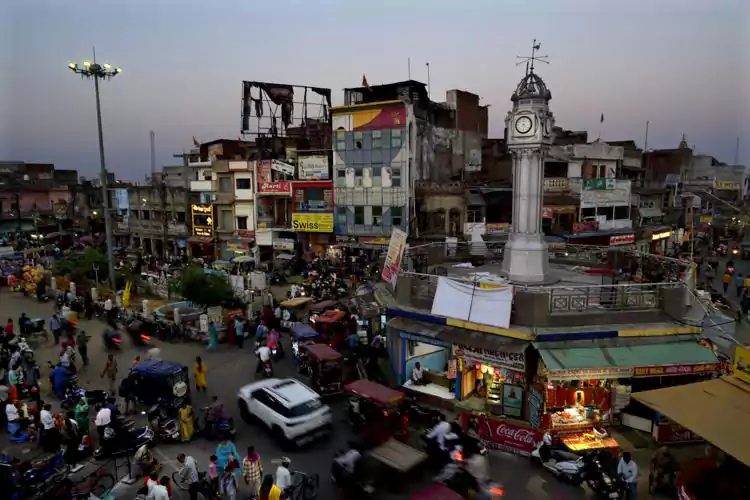Syed Mohammad Munir Abidi says India is a changed country, one he doesn’t recognize anymore.
It’s a country, the 68-year-old says, where Mus-lims are ignored, where rising attacks against them are encouraged, and where an emboldened Hindu majoritarian government is seizing its chance to put the minority community in its place.
Swami Ram Das thinks otherwise, echoing a be-lief system central to Hindu nationalism. The 48-year-old Hindu priest says India is on a quest to redeem its religious past and that the country is fundamentally a Hindu nation where minorities, especially Muslims, must subscribe to Hindu pri-macy.
Abidi and Das are two ordinary citizens living in one city in a country of more than 1.4 billion people that is on the cusp of becoming the world’s most populated nation. Together they embody the oppos-ing sides of a deeply entrenched religious divide that presents India with one of its biggest challenges: to safeguard freedoms for its Muslim minority at a time when a rising tide of Hindu nationalism is eroding the country’s secular underpinnings.
India will have an estimated 1.4286 billion people against China’s 1.4257 billion by mid-2023, accord-ing to United Nations projections. It is home to some 200 million Muslims who make up the pre-dominantly Hindu country’s largest minority group. They are scattered across almost every part of India, where a systemic anti-Muslim fury has descended since Prime Minister Narendra Modi first assumed power in 2014.
Though India’s communal fractures date back to its bloody partition in 1947, most Indians trace the roots of the latest religious fault lines to a small temple city in northern India, where the Hindu na-tionalist movement was galvanized in 1992 after Hindu mobs demolished a historic mosque to make way for a temple.
Since then, the city of Ayodhya has, in many ways, become a religious microcosm of India, where a diverse, multicultural past has gradually been over-run by ruptured relationships between Hindus and Muslims.
It’s also a city Abidi and Das call home. They have meandered through its narrow, winding streets overrun by temple monkeys and Hindu monks who ask passersby for alms in exchange for blessings. They have walked past its brimming bazaars where miniature idols of Ram are sold to pilgrims visiting from India’s vast hinterlands. They have begun their mornings with calls for prayers spilling out of mosque loudspeakers and Vedic hymns chant in the temples.
Beyond these shared experiences lie stark dif-ferences. For Das, a broad-shouldered man with a stout frame, Ayodhya is the birthplace of Ram, Hin-duism’s most revered deity. The city also hosts one of Hinduism’s most sacred sites — Ram’s grand temple — which will open to pilgrims next year. It is imperative that the city clings to its Hindu character, Das says.
“Our forefathers have fought for this temple and sacrificed lives for it. Today their dream is getting fulfilled,” he says, circled by a group of devotees.
The temple is being constructed where the 16th-century Babri mosque was demolished by Hindu hardliners who claim Muslim rulers built it at the exact spot where Ram was born. When it was razed on Dec. 6, 1992, Das was there, watching a frenzied Hindu mob climb its rounded domes and tear it down with pickaxes and crowbars.
“There was so much excitement to destroy that disgraced structure that no one cared about the falling debris,” he recounts, prompting his disciples to chant “Jai Sri Ram,” or “Hail Lord Ram,” a slogan that has become a battle cry for Hindu nationalists.
The 30-year campaign to build the temple saw subsequent religious violence and a bitter legal battle over the site that Hindus won in 2019. Muslims were given alternate land on the city outskirts to build a new mosque. A year later, Modi attended the temple’s groundbreaking ceremony.
For Abidi, a tall man in clothes that hang off his frame, it marked a sad chapter for India’s Muslims.
“The hearts of Muslims are broken. No Muslim opposes the construction of Ram temple, but such unilateral changes are impacting India’s culture,” he says, arguing the former mosque was essential to the city’s Muslim identity.
As for his city, it has already gone through major changes. For decades Ayodhya city was part of Uttar Pradesh state’s Faizabad district. But in 2018, authorities changed the entire district’s name from Faizabad to Ayodhya, a move that reflected the Modi government’s pattern of replacing prominent Muslim geographic names with Hindu ones.
For Abidi it indicates a worrying trend: “To erase everything that remotely reflects Muslim culture.”—APP










